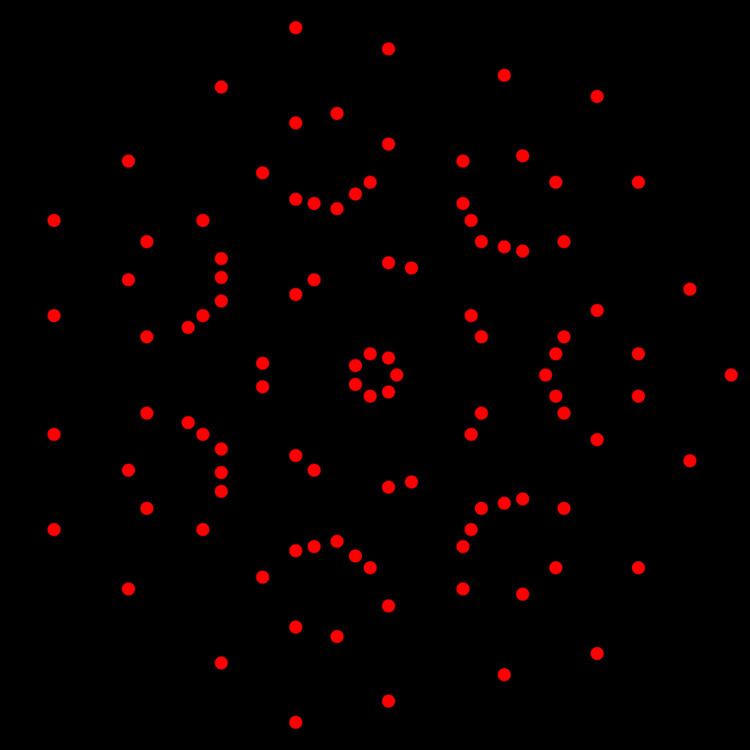 | ||
In six-dimensional geometry, a uniform polypeton (or uniform 6-polytope) is a six-dimensional uniform polytope. A uniform polypeton is vertex-transitive, and all facets are uniform 5-polytopes.
Contents
- History of discovery
- Uniform 6 polytopes by fundamental Coxeter groups
- Uniform prismatic families
- Enumerating the convex uniform 6 polytopes
- The A6 family
- The B6 family
- The D6 family
- The E6 family
- Non Wythoffian 6 Polytopes
- Regular and uniform honeycombs
- Regular and uniform hyperbolic honeycombs
- References
The complete set of convex uniform polypeta has not been determined, but most can be made as Wythoff constructions from a small set of symmetry groups. These construction operations are represented by the permutations of rings of the Coxeter-Dynkin diagrams. Each combination of at least one ring on every connected group of nodes in the diagram produces a uniform 6-polytope.
The simplest uniform polypeta are regular polytopes: the 6-simplex {3,3,3,3,3}, the 6-cube (hexeract) {4,3,3,3,3}, and the 6-orthoplex (hexacross) {3,3,3,3,4}.
History of discovery
Uniform 6-polytopes by fundamental Coxeter groups
Uniform 6-polytopes with reflective symmetry can be generated by these four Coxeter groups, represented by permutations of rings of the Coxeter-Dynkin diagrams.
There are four fundamental reflective symmety groups which generate 153 unique uniform 6-polytopes.
Uniform prismatic families
Uniform prism
There are 6 categorical uniform prisms based on the uniform 5-polytopes.
Uniform duoprism
There are 11 categorical uniform duoprismatic families of polytopes based on Cartesian products of lower-dimensional uniform polytopes. Five are formed as the product of a uniform 4-polytope with a regular polygon, and six are formed by the product of two uniform polyhedra:
Uniform triaprism
There is one infinite family of uniform triaprismatic families of polytopes constructed as a Cartesian products of three regular polygons. Each combination of at least one ring on every connected group produces a uniform prismatic 6-polytope.
Enumerating the convex uniform 6-polytopes
- {34} - 6-simplex -
- {4,33} — 6-cube (hexeract) -
- {33,4} — 6-orthoplex, (hexacross) -
- {3,32,1}, 121 6-demicube (demihexeract) - ; also as h{4,33},
- {3,3,31,1}, 211 6-orthoplex -
- {3,3,32,1}, 221 -
- {3,32,2}, 122 -
These fundamental families generate 153 nonprismatic convex uniform polypeta.
In addition, there are 105 uniform 6-polytope constructions based on prisms of the uniform 5-polytopes: [3,3,3,3,2], [4,3,3,3,2], [5,3,3,3,2], [32,1,1,2].
In addition, there are infinitely many uniform 6-polytope based on:
- Duoprism prism families: [3,3,2,p,2], [4,3,2,p,2], [5,3,2,p,2].
- Duoprism families: [3,3,3,2,p], [4,3,3,2,p], [5,3,3,2,p].
- Triaprism family: [p,2,q,2,r].
The A6 family
There are 32+4−1=35 forms, derived by marking one or more nodes of the Coxeter-Dynkin diagram. All 35 are enumerated below. They are named by Norman Johnson from the Wythoff construction operations upon regular 6-simplex (heptapeton). Bowers-style acronym names are given in parentheses for cross-referencing.
The A6 family has symmetry of order 5040 (7 factorial).
The coordinates of uniform 6-polytopes with 6-simplex symmetry can be generated as permutations of simple integers in 7-space, all in hyperplanes with normal vector (1,1,1,1,1,1,1).
See also list of A6 polytopes for graphs of these polytopes.
The B6 family
There are 63 forms based on all permutations of the Coxeter-Dynkin diagrams with one or more rings.
The B6 family has symmetry of order 46080 (6 factorial x 26).
They are named by Norman Johnson from the Wythoff construction operations upon the regular 6-cube and 6-orthoplex. Bowers names and acronym names are given for cross-referencing.
See also list of B6 polytopes for graphs of these polytopes.
The D6 family
The D6 family has symmetry of order 23040 (6 factorial x 25).
This family has 3×16−1=47 Wythoffian uniform polytopes, generated by marking one or more nodes of the D6 Coxeter-Dynkin diagram. Of these, 31 (2×16−1) are repeated from the B6 family and 16 are unique to this family. The 16 unique forms are enumerated below. Bowers-style acronym names are given for cross-referencing.
See list of D6 polytopes for Coxeter plane graphs of these polytopes.
The E6 family
There are 39 forms based on all permutations of the Coxeter-Dynkin diagrams with one or more rings. Bowers-style acronym names are given for cross-referencing. The E6 family has symmetry of order 51,840.
See also list of E6 polytopes for graphs of these polytopes.
Non-Wythoffian 6-Polytopes
In 6 dimensions and above, there are infinite amount of non-Wythoffian convex uniform polytopes as the Cartesian product of the Grand antiprism in 4 dimensions and a regular polygon in 2 dimensions. It is not yet proven whether or not there are more.
Regular and uniform honeycombs
There are four fundamental affine Coxeter groups and 27 prismatic groups that generate regular and uniform tessellations in 5-space:
Regular and uniform honeycombs include:
Regular and uniform hyperbolic honeycombs
There are no compact hyperbolic Coxeter groups of rank 6, groups that can generate honeycombs with all finite facets, and a finite vertex figure. However, there are 12 noncompact hyperbolic Coxeter groups of rank 6, each generating uniform honeycombs in 5-space as permutations of rings of the Coxeter diagrams.
